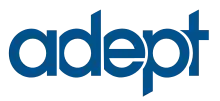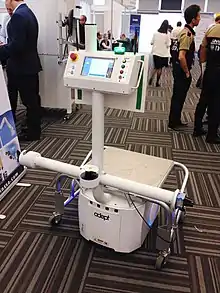Omron Adept
Omron Adept Technology, Inc. is a multinational corporation with headquarters in Pleasanton, California (San Francisco Bay Area). The company focuses on industrial automation and robotics, including software and vision guidance. Adept has offices throughout the United States as well as in Dortmund, Germany, Paris, France, and Singapore. Adept was acquired by Omron in October 2015.[3]
 | |
| Type | Subsidiary |
|---|---|
| Industry | Robotics, Industrial Automation |
| Founded | 1983 |
Number of locations | Pleasanton, California, United States |
Key people | Rob Cain (CEO), John D. Dulchinos |
| Revenue | |
| Total assets | |
| Total equity | |
Number of employees | 158[2] |
| Parent | Omron |
| Website | www |
Company history
Adept was founded in 1983, and was formerly the West Coast Division of Unimation, which became part of Westinghouse after being a division of Consolidated Diesel Electronic (Condec) for many years. However, its roots go back almost 10 years earlier, when company founders Bruce Shimano and Brian Carlisle, both Stanford graduate students, started to work with Victor Scheinman at Stanford's AI lab.
In 2000, Adept Technology acquired Pensar Tucson Inc.[4]
Today, the company is active in a variety of industries requiring high speed, precision part handling including food handling, consumer product and electronics, packaging, medical and lab automation, automotive, as well as emerging markets like solar manufacturing.
Robots

In 1984, the company introduced its first product, the AdeptOne SCARA robot. AdeptOne robots continue to be in use worldwide in 2009.
Around 2004, Adept introduced table-top SCARA robots called the Adept Cobra i600/i800, with the system and servo controls, and the power amplifiers, embedded in the base of the robot. The related Adept Cobra s600/s800 models employ an external controller (with the servo controls and amplifiers still in the robot base) to achieve greater system functionality. These robots are claimed to be the fastest robots in their class.
In 2006, Adept released its new delta-4 robot, the Adept Quattro. It is based on a new concept (invented by French and Spanish researchers and described in the European patent EP 1 870 214 B1 ) of delta-style robot mechanism that has four arms versus the traditional three-arm design. The rotation is achieved through a parallel platform.
In 2010, Adept purchased MobileRobots Inc, maker of autonomous platforms and guidance software for research and industrial applications.[5] After purchase by Omron, these intelligent vehicles became the Omron Adept LD series.[6]
Adept also offers Adept Python linear-module robots with one to four axes in various configurations, and six-axis Adept Viper articulated robots.
In 2015, Omron acquired Adept Technologies.[7]
Vision Software
Scott Roth of the west coast division of Unimation implemented an interface to the Machine Intelligence Corporation (MIC) vision system VS-100 in early 1981. It was a binary system using blob (connectivity) analysis. Unimation’s first vision system was called Univision I for Puma robots. [8]
When the west coast division of Unimation split off to become Adept Technology, Scott continued to develop the robot vision system under an agreement whereby Adept agreed to grant back software enhancements to Unimation over a period of time [1 or 2 years?]. This also applied to VAL, the robot programming language. Adept called the vision system AdeptVision. Scott was joined by Fred Andresen in 1984, who wrote some vision tools and AIM VisionWare, the GUI.
AdeptVision is probably the first commercially available robot vision system that achieved sales in the thousands of units. AdeptVision included many vision-related operations for image capture, enhancement, and analysis. It provided machine guidance with robot-vision calibration and supported on-line gauging and assembly verification. Provided functionality included rulers (line and arc), windows (rectangular, round, annulus, and pie-shaped regions of interest), feature finders (line and arc fitters), normalized grayscale correlation, blob analysis, processing tools (gradient or Sobel edge detection, thresholding, morphology, image subtraction, histogram, frame copy, pan & zoom, and convolutions), and feature-based recognition. [9] The rotation and scale invariant ObjectFinder was patented.[10]
The “ruler” created by Fred Andresen is an important metrology tool that locates edges along a line or arc with sub-pixel accuracy. The linear version operates in any orientation and is the basis of the line and arc fitters, providing high accuracy in grayscale images.
AdeptVision systems ranged from binary linescan for conveyor belts to binary and grayscale 2-D images. The systems evolved from the Q-bus to Multibus to the VME bus. The first system consisted of the DEC LSI-11/23 CPU, EG&G Reticon line camera, camera interface board that included a run-length processor, a Peritek display processor board (512 x 512 x 1 bitmap), and a B&W display/terminal.
The various versions of the vision systems over time included AdeptVision I [256 x 241 x 1-bit binary], AdeptVision II [375 x 483 x 1-bit binary], AdeptVision ML [256 x 1-bit for moving line], -XGS [509 x 481 x 7-bit grayscale], -XGS II [509 x 481 x 7-bit grayscale], -AGS [512 x 484 x 8-bit grayscale], -AGS II, -AGS-GV [512 x 484 x 8-bit grayscale], -VME [640 x 480 or 1024 x 1024 x 7-bit grayscale], and -VXL. The AdeptVision XGS and AGS systems were particularly popular in the Adept’s early history with 1000 AdeptVision AGS systems alone having been shipped as of January 25, 1993.
Hardware and Software History
Adept has its own robot control operating system, V+, which has come to version 17.x by 2009. The history of V+ dates back to the days of Unimation. At the time it was called VAL (Victor's Assembly Language), which evolved into VAL-II and VAL-III later. After the formation of Adept, the rights to parts of the OS were granted to Adept..
The Adept OS at that time was called V, and it ran on the refrigerator-sized controllers that were based on the MultiBus technology. Around 1986 the Adept MC controller was introduced; while still based on the MultiBus, it was smaller than the original controller. After the Adept MC controller (around 1990), came the Adept MV controller, which was based on the VME backplane technology. Then around 2000 the SmartController CS/CX controllers were introduced, which are current production as of 2009.
Along with the changes of the controller itself, the servo controls also saw major improvements over the years. Around 200x, with the V+ version reaching ver. 14, the servo amplifier and controls were part of the robot, and hence separated from the main robot controller itself. This is when distributed controls were introduced by the company. The idea of having the amplifier and servo controls in the base of the robot was named AIB (Amplifier in Base). Adept still follows the AIB mantra, and has an AIB in the latest robot, Adept Quattro, reducing the footprint of the robot/manipulator/controller system.
Controls
The Adept core business continues to be motion control. Its SmartController CX integrates motion controller, vision guidance, and interfaces to factory networks.
References
- "Adept Technology Reports Fiscal Year 2014 Fourth Quarter and Full Year Results". Archived from the original on 2014-08-28. Retrieved 2014-08-25.
- "Company Profile for Adept Technology Inc (ADEP)". Retrieved 2008-10-20.
- "OMRON Completes Acquisition of Adept Technology - Addition of Leading Provider of Intelligent Robots to Strengthen Industrial Automation Business - | News Releases | OMRON Global". www.omron.com. Retrieved 2016-08-19.
- "Adept Technology Completes Acquisition of Pensar Tucson". May 4, 2000. Archived from the original on July 11, 2013. Retrieved Jul 11, 2013.
- https://www.roboticsbusinessreview.com/manufacturing/market-potential-drives-adept-acquisition-of-mobilerobots/
- https://automation.omron.com/en/us/products/family/LD
- https://www.omron.com/media/press/2015/09/c0916.html
- Carlisle, Brian and Roth, Scott. The PUMA/VS-100 Robot Vision System, 1st International Conference on Robot Vision and Sensory Controls, Stratford-upon-Avon, UK, April 1-3, 1981.
- Roth, Scott. New Vision System Recognizes Touching Parts, ROBOTS 8 Conference Proceedings (SME) 1984, pp. 14-1 to 14-12.]
- Roth, Scott. Patent #6,272,247, entitled ROTATION AND SCALE INVARIANT IMAGE FINDER.
External links
- Official website
- Carnegie Mellon Hall of Fame
- Learn about Robots: Industrial Robots
- Adept Pioneer 3-DX and Adept Pioneer 3-AT model and device list
References: ABB, Fanuc, Denso, Epson Robots, KUKA